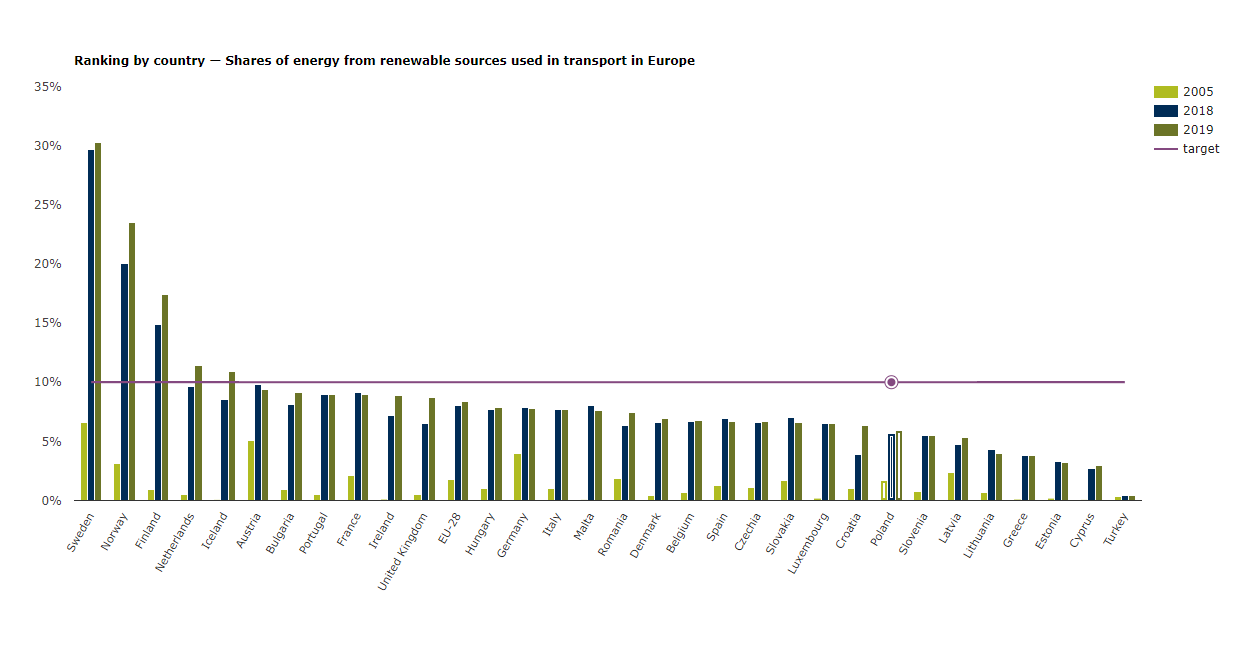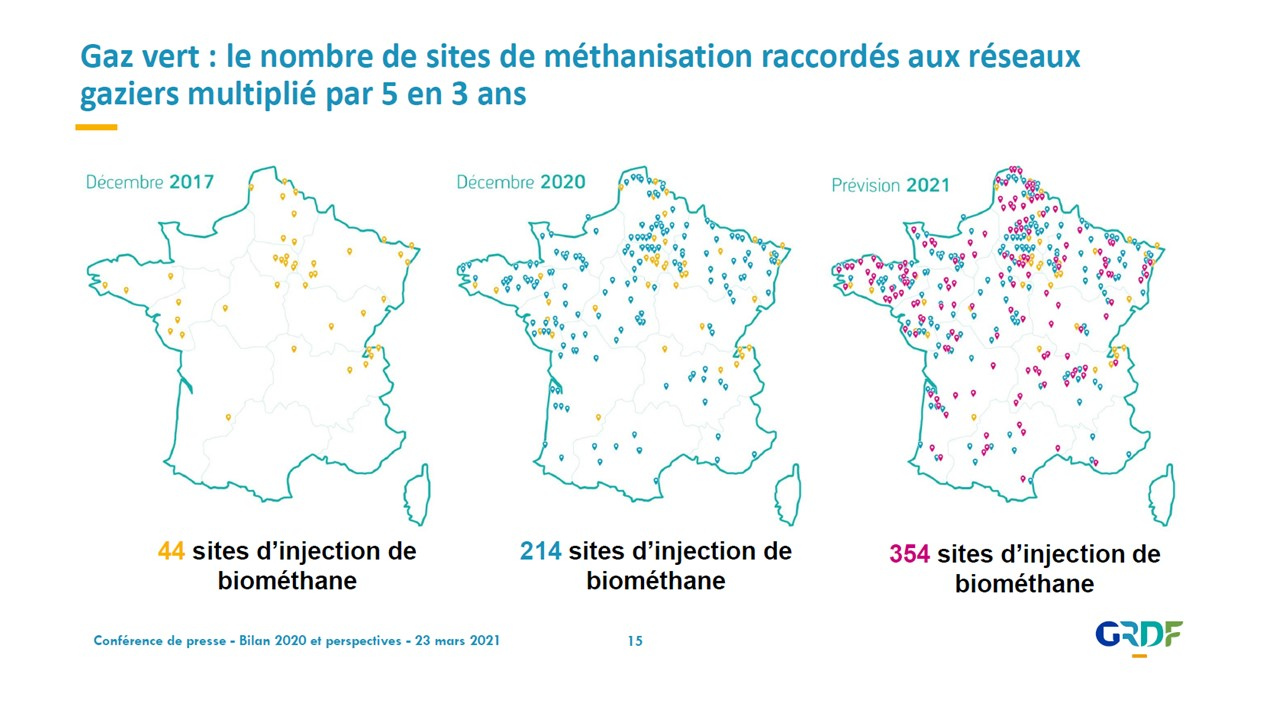Biomethane as Transport Fuel: A Green Solution for Carbon Neutrality in Europe
Five years after the Paris Agreement (2016), the demand for green energy in transport has never stopped growing in the European Union (EU). Transportation is responsible for more than 30% of greenhouse gas emissions in Europe and it is nearly entirely dependent on oil and fossil fuel.
The development of biofuels from renewable sources, such as biogas upgraded to the quality of natural gas, or better known as biomethane, will play an important part towards bridging conventional fuels and advanced biofuels of the next generations.
Renewable Energy Directive (RED II)
Renewable Energy Directive is the main legislative support for the development of renewable energies, including biogas and biomethane, in Europe. The new version called RED II was adopted iIn 2018 and sets a legally binding renewable target for 2030 of at least 32% that may be reviewed upward in 2023.
RED II includes as well sector-specific objectives and aims an annual increase of 1.3% for renewable energy in the heating sector and an end target of 14% renewables in the transport sector by 2030 (EBA). This legislation is a step forward for biomethane or renewable gas utilization in Europe as it extends guarantees of origin for renewable gas, opens up the access of biomethane to natural gas grid and facilitates the cross-border biomethane trade.
RED II is perceived as the main incentive to decarbonize the transport sector that already saw 8% of total energy used in transport coming from renewable sources in 2018 per European Environment Agency (up from 2% in 2005).
Each EU member state is required to implement RED II requirements into national law by 30 June 2021. While the targets are straight forward and the progress is visible, it is up to each country to choose the way they want to reach these goals as each country is different as you can see in the figure below:

Support Schemes in Europe
While some support schemes under RED II are still being developed, there are a number of countries that use different approaches to incentivize producers and suppliers to endorse biomethane as a sustainable fuel for transportation. To visualize support schemes in place, a study by
Regatrace Renewable Gas Trade Centre in Europe in 2020 provides the European overview below:
Benefits and Advantages of Using Biomethane in Transport Sector
When evaluating options to modernize the transportation sector in Europe, biomethane offers a great amount of short and long-term advantages not only on the short-term, but also on the long-term (EBA):
A Green Solution for the Environment
Biomethane remains a powerful weapon against climate change. Thanks to anaerobic digestion, methane emissions from sewage sludge, municipal waste, agro industrial effluents and agricultural residues are captured and prevented from polluting the atmosphere. These emissions can be 23 times more harmful than CO2.
Job Creation
The biogas sector accounts for over 70,000 stable jobs in Europe. A wide majority of biogas plants are located in rural areas, which contributes to helping local economy and creating high skilled positions.
Energy Security
With Europe’s external gas import dependency at 83% (2018), biomethane is regarded as a unique opportunity to offset the fossil fuel’s balance with a renewable and sustainable domestic gas source. Thus, developing the biomethane will favor energy security, instead of relying on fossil fuel coming from unstable regions where the political situation may interrupt supply chains.
Versatility and Availability
Anaerobic digestion is a fully developed and proven technology, which results in high energy production and good predictability levels, as well as great versatility. CNG and LNG filling stations may not be as dominant as their liquid fuel counterparts, but they are more available than refuelling installations for other alternative fuels such as electric and hydrogen-powered transport.
Potential to Decarbonize Various Transportation Sectors
European Biogas Association (EBA), Gas Infrastructure Europe (GIE), the Natural & bio Gas Vehicle Association (NGVA Europe) and SEA-LNG published a joint paper that highlights true potential for BioLNG to decarbonise heavy-duty transport and shipping in a fast and cost-effective way. The report predicts the EU production of BioLNG is set to increase tenfold by 2030 that will play an important role in transport decarbonization.
Additionally, the gas fueling infrastructure is expanding fast and recorded 4000 CNG and 400 LNG stations in place per NGVA Europe.
Current Challenges and Opportunities
For biomethane to replace natural gas in the future, Europe has to take additional steps to overcome sustainability and financial challenges.
For example, German biomethane can be considered less sustainable on average than the Danish or French biomethane, because of the higher threshold for energy crops as a feedstock. The availability of organic waste certainly varies across Member States. Danish and French biomethane consumers might then not accept a less-sustainable biomethane from Germany. As suggested by the Florence School of Regulation, this problem could be solved by the harmonization of sustainability thresholds, giving a clear definition of biomethane and its characteristics to expand trade.
Furthermore, on the short-term perspective, out of 343 million road vehicles in Europe from 2014 data, only 1.2 million run on natural gas and biomethane, the equivalent of 0.7% of the total vehicle market. Natural gas is used at a relatively small scale, as fossil fuels still dominate the market. With few or virtually no CNG and LNG fueling stations in several European countries, alternative solutions like home refilling facilities will force vehicle manufacturers to increase the costs for consumers, making the purchase of a gas-powered vehicle less attractive. It is thus imperative that renewable transport fuels are supported not only by public instances, but also private companies and associations.
Developments in Selected Countries
France
France showed an incredible growth in biomethane production over the last several years and is looking to green its different fleets further. As an example, Up to recently, the Transdev bus depot in the Île-de-France region has been transformed to accommodate buses running on biomethane. With this new development, the French organization Île-de-France Mobilités is hoping that all future buses in the region will consider biomethane.
France is as well looking at other types of transport that may use biomethane. Based on estimates by the management consulting firm Sia Partners, a BioNGV train network in France would lead to numerous benefits, such as creating 16,750 jobs, generating 1.5 billion euros in turnover and reducing CO2 emissions from the TER (Regional Express Trains) by 175,000 tons per year by 2030.
Approximately 563 TER trains could be converted to BioNGV between 2025 and 2030, which would affect 61% of the fleet and result in the consumption of 560 GWh of BioNGV in 2030, the equivalent of the consumption of 2,240 buses.
Belgium
In a recent interview with GMobility, Didier Hendrickx from Gas.be, the
Belgian Federation of Gas System Operators, shared his thoughts on the state of the biomethane market in Belgium. With 150 CNG stations, 80 LNG stations and nearly 23,000 vehicles on the road, the industry shows great potential for renewable natural gas. Since the first biomethane injection in 2018, there are currently more or less than 20 projects planned over the next 2 years in Belgium.
According to Hendrickx, there are 5 catalysts that could help stimulate the biomethane industry grow in the upcoming years:
- Create awareness, communication to a broad public is the key.
- Importance of OEMs (Original Equipment Manufacturer).
- Incentives from the authorities and the gas sector.
- Regulatory framework.
- Level playing field in terms of opportunities for alternative energy sources (hydrogen, electrical vehicles, etc.)
Convincing the public that BioLNG and BioCNG are part of the decarbonization process remains a great challenge, as well as persuading manufacturers that they can be beneficial financially.
Sweden
Sweden has currently the highest share of energy from renewable sources in transport with nearly 30%. For several years, Sweden has been putting the use of biogas and biomethane as green fuels in the forefront to achieve its goal, thanks to policies for NGV and BioNGV, major investments to boost the market, subsidies and tax exemptions for those choosing this type of fuel.
Sweden has launched a program to invest in local and regional efforts to reduce GHG emissions in 2015. Since then, it has invested a large part of the € 345 million granted in the installation of NGV and BioNGV in local public transport vehicles and charging stations throughout Sweden.
Today, more than 30 municipalities use biogas or biomethane vehicles for their public transport systems, including buses and taxis. For example, in Kalmar County, all buses run on fossil fuel-free fuel, 60% of which is biogas from farmyard manure.
In 2020, 1,491 GWh of vehicle gas were sold in Sweden. Biogas now accounts for 95% of sales of compressed vehicle gas. At the end of 2019, there were 53,982 gas vehicles in Sweden, 2,618 were buses, 1,034 heavy vehicles and the remaining passenger cars and vans.

Source: Vehicle Gas Statistics, Energigas Sverige (2020)
Recent Developments
GRDF’s 2020 review confirms biomethane boom in France
In March 2021, the French gas distribution company GRDF revealed that 226 biomethane plants were currently injecting biomethane into the gas networks and they were expecting nearly 354 injection sites by the end of 2021.

Source: GRDF, 2021
S. Pellegrino relies on trucks with biomethane and electricity
In an effort to focus on sustainability in transport, the Italian manufacturer S. Pellegrino is now using electric and biomethane trucks for the first time in southern Germany. “We already transport 80 percent of our mineral water from Italy to Germany by train. Compared to conventional truck traffic, an average of 3,900 tons of CO₂ can be saved each year, “explains Marc Honold, Managing Director of Nestlé Waters Germany & Austria (Top Agrar Online, 2021).
Minister announces HDV Grant Scheme to encourage companies towards zero or lower carbon emission vans, trucks and buses
The Irish Minister of Transport announced in March 2021 new grants to support businesses to switch from diesel heavy duty vehicles to electric or alternatively fueled vehicles. The €2m Alternatively-Fueled Heavy Duty Vehicle (AFHDV) Purchase Grant Scheme is part of the Government of Ireland’s plan to decarbonise the transport sector, in which HDVs contribute to almost 20% of Irish land transport emissions. Companies may now be eligible for support up to the value of €500K and/or 20 heavy duty vehicles.
Sources:
- Sales of liquefied vehicle gas up 230%, Energigas Sverige (2020)
- The Future Role of Gas in Transport, Cadent (2021)
- Mapping the state of play of renewable gases in Europe, Regatrace (2020)
- Over on key EU policies for the biogas sector, European Biogas Association (2018)
- Biomethane as Transport Fuel,
Magdalena Rogulska, Paweł Bukrejewski and Ewa Krasuska (2018) - Towards a common European biomethane market, Florence School of Regulation (2020)
- Renewable Energy Directive, European Commission (2018)
- Minister announces HDV Grant Scheme to encourage companies towards zero or lower carbon emission vans, trucks and buses, Government of Ireland (2021)
- S.Pellegrino setzt auf Lkw mit Biomethan und Strom, Top Agrar Online (2021)
- Bilan 2020 et perspectives, GRDF (2021)
- NGVA Europe has published 2020 gas vehicle statistics and Europe has reached a new gas refuelling infrastructure milestone, NGVA Europe (2021)
- RED II Compromise – EBA Summary, EBA (2018)
- Scaling-up Renewable Gas, EBA (2021)
- Didier Hendrickx on gmobility in Belgium, GMobility (2021)
- What Impacts Could a BioGNV Train Network Have?, SIA Partners (2021)

